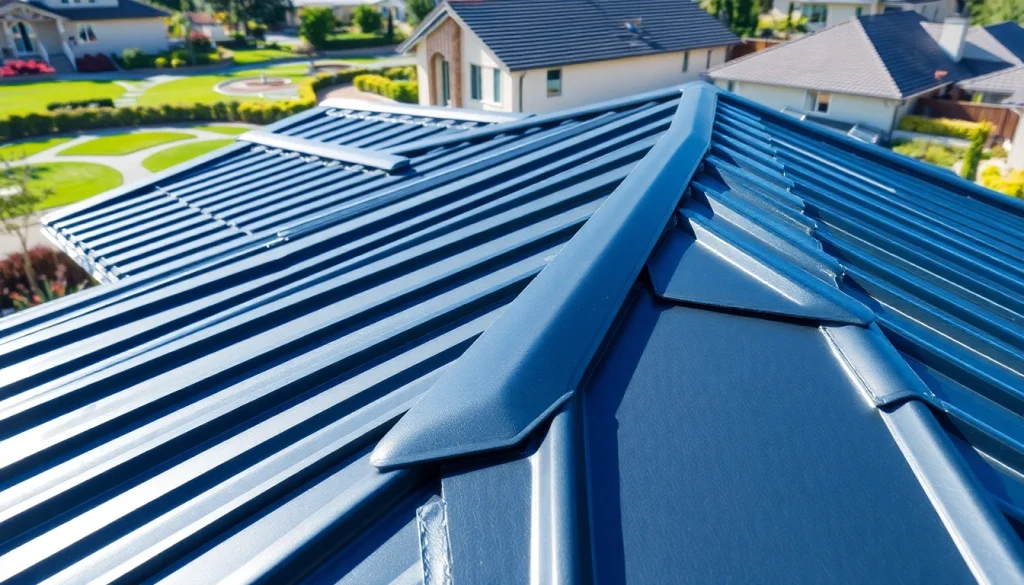Understanding Residential Metal Roofing
What is Residential Metal Roofing?
Residential metal roofing has gained popularity as a durable, stylish, and energy-efficient alternative to traditional roofing materials like asphalt shingles and tiles. It encompasses various metal materials—such as aluminum, steel, zinc, and copper—that are used to protect residential buildings. Unlike traditional roofs, metal roofs are designed to withstand harsh weather conditions, resist corrosion, and offer a longevity that can surpass several decades. Given their myriad benefits, many homeowners are turning to residential metal roofing as a smarter investment for their homes.
Advantages of Metal Roofing Over Traditional Materials
The advantages of metal roofing are not just superficial; their societal impacts on energy consumption and sustainability make them an excellent choice for residential buildings. Here are several crucial benefits:
- Durability: Metal roofs are notably resilient against wind, rain, hail, and extreme temperatures. Most can endure winds of up to 140 mph and resist corrosion over time.
- Energy Efficiency: Reflective metal roofs can significantly lower cooling costs in warm climates by reflecting solar radiant heat. Some types even feature energy-efficient coatings that enhance their thermal performance.
- Longevity: While traditional asphalt roofing typically has a lifespan of 15-30 years, metal roofs can last up to 50 years or more, reducing long-term replacement costs.
- Environmental Benefits: Many metal roofing products are made from recycled materials and are themselves recyclable at the end of their lifespan, making them a sustainable option for environmentally conscious homeowners.
- Aesthetic Versatility: Metal roofing is available in various styles, colors, and textures, making it easy to integrate into the design of almost any home.
Popular Styles of Residential Metal Roofs
The aesthetic options available with residential metal roofing can enhance the visual appeal of almost any home. Popular styles include:
- Standing Seam: Recognized for its raised, interlocking seams, this style is known for its sleek aesthetics and superior weather resistance.
- Corrugated Metal: This style offers a more industrial look and is often used for barns as well as residential homes. Its wavy structure provides strength and a unique appearance.
- Metal Shingles: Resembling traditional shingles, metal shingles are designed to give a classic appearance while providing metal roofing benefits.
- Metal Tile: Often mimicking traditional clay or slate tiles, this style offers a strikingly elegant facade while being significantly lighter and more durable.
Types of Residential Metal Roofs
Standing Seam Metal Roofing
Standing seam metal roofing features vertical seams that are raised above the plane of the roof. This design provides enhanced water and snow runoff, preventing leaks from occurring. The concealed fastener system enhances durability while minimizing the risk of corrosion. Homeowners appreciate this option for its clean lines, making it a perfect match for contemporary architectural styles.
Corrugated Metal Roofing
Corrugated metal roofing is characterized by its wave-like patterns, which create ridges and valleys. It’s a more budget-friendly metal roofing option and provides excellent structural strength, making it ideal for homes in windy regions. Its low maintenance requirements and lightweight nature also contribute to its growing popularity among homeowners looking for durable yet economical roofing solutions.
Metal Slate and Tile Roofing Options
Metal slate roofing combines the rugged appearance of traditional slate with the durability of metal. This design offers all the aesthetic benefits of slate while significantly reducing weight and installation costs. Similarly, metal tile systems replicate the architectural appeal of clay or ceramic tiles, providing homeowners with beautiful options without the drawbacks of traditional materials.
Choosing the Right Metal Roof for Your Home
Factors to Consider When Selecting Metal Roofing
Choosing the right metal roof involves considering multiple factors, including:
- Climate: The local climate significantly impacts the type of metal roofing that would be most effective. Consider factors like snowfall, rain, and wind speed.
- Home Architecture: The style of your home can influence the type of metal roofing that would best complement its aesthetics.
- Budget: While metal roofs can be more cost-effective in the long term, their initial investment may vary. Budget accordingly for the roofing style that meets your needs.
- Installation Variables: Weigh the costs and benefits of professional installation versus opting for a DIY approach. Some types of metal roofing require specialized installation skills.
Residential Metal Roofing Prices
Residential metal roofing pricing can vary significantly based on the type of metal, the installation complexity, and the geographic location. On average, metal roofs range from $5 to $12 per square foot, with standing seam installations particularly at the higher end of the scale. It is essential to obtain multiple quotes from contractors to find the best deal while ensuring quality workmanship.
Common Installation Mistakes to Avoid
Even with its straightforward installation, many homeowners make crucial errors that can compromise the roofing’s integrity. Common mistakes include:
- Improper Underlayment: Failing to install a quality underlayment can result in moisture issues and void manufacturer’s warranties.
- Insufficient Overlaps: Overlapping sections incorrectly can lead to leaks and structural weakness.
- Poor Ventilation: Inadequate ventilation can create heat and moisture buildup, shortening the roof’s lifespan.
Benefits of Residential Metal Roofing
Energy Efficiency and Environmental Impact
Metal roofs are recognized for their energy-efficient properties. Their reflective surfaces can lower cooling costs by up to 25%, benefiting homeowners in hot climates. Additionally, many metal roofing materials are made from recycled content and can itself be recycled at the end of their lifecycle, further reducing their environmental footprint.
Longevity and Maintenance of Metal Roofs
One of the standout benefits of metal roofs is their longevity. Typically, metal roofing lasts 40-70 years depending on the material used. Furthermore, maintenance is generally minimal, requiring occasional inspections and cleaning to ensure debris is cleared away. Metal roofs are also resistant to common concerns like rot and pest damage, reducing the need for frequent repairs.
Boosting Curb Appeal and Property Value
Homeowners who choose metal roofing often see an immediate increase in curb appeal and property value. The numerous styles and colors available allow homeowners to customize their roofing to match their exterior design preferences, enhancing the overall aesthetic appeal. Moreover, a well-installed metal roof can yield a higher return on investment, making it an attractive choice for potential homebuyers.
Installation and Care for Residential Metal Roofing
Hiring Professionals vs. DIY Installation
While some homeowners may consider a DIY approach to install metal roofing, hiring professionals is often the more prudent option. Experienced contractors not only possess the necessary tools and expertise but also understand the nuances involved in working with different metal types. Proper installation is critical for maximizing the benefits of the roof, such as durability, energy efficiency, and proper ventilation.
Essential Maintenance Tips for Metal Roofs
To extend the life of your metal roof, adhere to these essential maintenance tips:
- Conduct annual inspections for rust, corrosion, or loose fasteners.
- Ensure gutters and downspouts are clear of debris to prevent water buildup.
- Clean the roof surface periodically to remove dirt and organic materials that can degrade the metal.
Signs That Your Residential Metal Roof Needs Repair
Being proactive about roof maintenance involves recognizing the signs that repairs may be needed. Watch for the following indicators:
- Visible rust spots or discoloration.
- Loose or missing panels or seams.
- Water stains on ceilings or walls indicating leaks.


